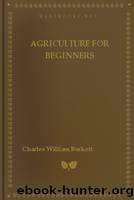Agriculture for Beginners by Charles William Burkett

Author:Charles William Burkett
Language: eng
Format: epub
Publisher: ManyBooks.net
CHAPTER IX
FEED STUFFS
SECTION LI. GRASSES
Under usual conditions no farmer expects to grow live stock successfully and economically without setting apart a large part of his land for the growth of mowing and pasture crops. Therefore to the grower of stock the management of grass crops is all-important.
In planting either for a meadow or for a pasture, the farmer should mix different varieties of grass seeds. Nature mixes them when she plants, and Nature is always a trustworthy teacher.
In planting for a pasture the aim should be to sow such seeds as will give green grass from early spring to latest fall. In seeding for a meadow such varieties should be sowed together as ripen about the same time.
Even in those sections of the country where it grows sparingly and where it is easily crowded out, clover should be mixed with all grasses sowed, for it leaves in the soil a wealth of plant food for the grasses coming after it to feed on. Nearly every part of our country has some clover that experience shows to be exactly suited to its soil and climate. Study these clovers carefully and mix them with your grass seed.
The reason for mixing clover and grass is at once seen. The true grasses, so far as science now shows, get all their nitrogen from the soil; hence they more or less exhaust the soil. But, as several times explained in this book, the clovers are legumes, and all legumes are able by means of the bacteria that live on their roots to use the free nitrogen of the air. Hence without cost to the farmer these clovers help the soil to feed their neighbors, the true grasses. For this reason some light perennial legume should always be added to grass seed.
[Illustration: FIG. 226. SINGLE PLANT OF GIANT MILLET]
It is not possible for grasses to do well in a soil that is full of weeds. For this reason it is always best to sow grass in fields from which cultivated crops have just been taken. Soil which is to have grass sowed in it should have its particles pressed together. The small grass seeds cannot take root and grow well in land that has just been plowed and which, consequently, has its particles loose and comparatively far apart. On the other hand, land from which a crop of corn or cotton has just been harvested is in a compact condition. The soil particles are pressed well together. Such land when mellowed by harrowing makes a splendid bed for grass seeds. A firm soil draws moisture up to the seeds, while a mellow soil acts as a blanket to keep moisture from wasting into the air, and at the same time allows the heated air to circulate in the soil.
In case land has to be plowed for grass-seeding, the plowing should be done as far as possible in advance of the seeding. Then the plowed land should be harrowed several times to get the land in a soft, mellow condition.
Download
This site does not store any files on its server. We only index and link to content provided by other sites. Please contact the content providers to delete copyright contents if any and email us, we'll remove relevant links or contents immediately.
Turbulence by E. J. Noyes(7039)
The Thirst by Nesbo Jo(5785)
Gerald's Game by Stephen King(3918)
Be in a Treehouse by Pete Nelson(3213)
Marijuana Grower's Handbook by Ed Rosenthal(3119)
The Sprouting Book by Ann Wigmore(3053)
The Red Files by Lee Winter(2914)
The Remains of the Day by Kazuo Ishiguro(2618)
Sharp Objects: A Novel by Gillian Flynn(2445)
Christian (The Protectors Book 1) by L. Ann Marie(2394)
Organic Mushroom Farming and Mycoremediation by Tradd Cotter(2307)
The Culinary Herbal by Susan Belsinger(2062)
Stone Building by Kevin Gardner(1995)
The Starter Garden Handbook by Alice Mary Alvrez(1925)
Lilac Girls by Martha Hall Kelly(1876)
The Unlikely Pilgrimage of Harold Fry by Rachel Joyce(1836)
The Lean Farm Guide to Growing Vegetables: More In-Depth Lean Techniques for Efficient Organic Production by Ben Hartman(1785)
Urban Farming by Thomas Fox(1749)
Backyard Woodland by Josh VanBrakle(1587)
